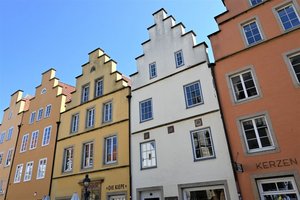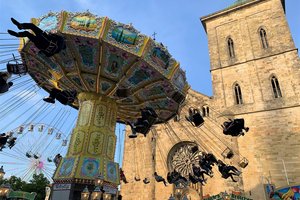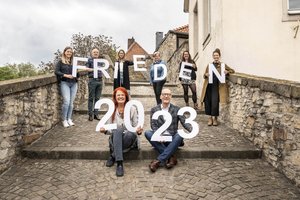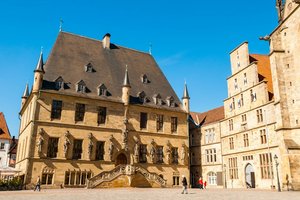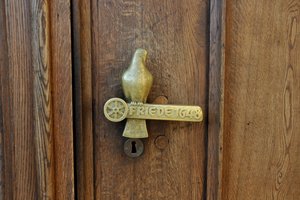Two historic buildings impressively frame the street “Neuer Graben” in Osnabrück: the Ledenhof and Osnabrück Castle. Both buildings look back on an eventful past and today serve as places of the future: the Ledenhof as the seat of the German Foundation for Peace Research and the Literature Office of West Lower Saxony, the castle as the administrative headquarters of the University of Osnabrück.
The Ledenhof
The origins of the castle, which stands out due to its colourfully decorated stone facade, date back to the 14th century. In the Middle Ages it served as the town seat of the patrician and noble family of Leden. Three important parts of the originally spacious courtyard complex have survived to this day: the granary in quarry stone masonry with its typical gable roof, the newly plastered, colourfully designed palace with its ornamental gables and the stair tower from the 16th century. The granary, a former warehouse, is the oldest part of the building. It was expanded by complex alterations in the 15th century from three to seven storeys. The palace served as the residence of the von Leden family. The former banqueting hall on the first floor with its large fireplace and beams and planks decorated with early Renaissance motifs still shows the noble family's desire for representation. It now offers space for cultural events. Until the 20th century, the name "Alte Münze" (Old Mint) was used for the entire complex; there probably used to be a mint (an industrial facility which manufactures coins that can be used as currency) in the Ledenhof. The university library "Alte Münze" opposite the Ledenhof still bears this name. The Ledenhof has been owned by the city of Osnabrück since 1930. It was in danger of falling into disrepair during and after the Second World War but was extensively renovated between 1964 and 1976.
German Foundation for Peace Research
In 2002, the German Foundation for Peace Research moved into the ground floor of the Ledenhof. This was founded in October 2000 by the Federal Republic of Germany (represented by the Ministry of Education and Research) as an institution for the promotion of research in the field of peace and conflict research. One of the aims of the funded projects is to create the prerequisites and conditions for preventing war, poverty, hunger and oppression, to uphold human rights and to use natural resources and development opportunities and preserve them for future generations.
Osnabrück Castle during the Third Reich
In 1937/38, the west wing of the castle, which had been built between 1667 and 1675 as a prince-bishop's residence, was converted for use by the Secret State Police (Gestapo). It had offices, prison cells, interrogation and torture rooms there. One area of the cellar was used as an air-raid shelter during the war and was preferred by the Gestapo for its "intensified interrogations." Since 2001, the The Gestapokeller (Gestapo cellar) Memorial has been located in the preserved detention cells.
After the Pogrom Night, in November 1938, Jewish Osnabrückers were imprisoned in the cellars before being deported to Buchenwald concentration camp. Later, political prisoners, other Jewish citizens as well as foreign forced labourers were also initially held in the cells. A plaque on the west wing has referred to the victims of the Gestapo in Osnabrück since 1995.
Augustaschacht Memorial
The forced labourers who were briefly imprisoned in the castle were interned in the Labour Education Camp Ohrbeck near Hasbergen under concentration camp-like conditions from 1944 onwards. Around 2,000 inmates passed through the camp until the end of the war in 1945, the largest group being Dutch. Among other things, they were used for forced labour in the Georgsmarienhütte ironworks or to clear the bomb debris in Osnabrück. Today, the Augustaschacht Memorial is located in the former camp.
The Stolpersteine
On the street “Neuer Graben” there is a Stolperstein (memorial stone) with the name Maria Westendorf. Born in Osnabrück in 1939, she was almost certainly a victim of the "Children’s euthanasia" (a Nazi crime in psychiatry) in the Lüneburg state sanatorium during the Second World War.
In 2006, the Osnabrück City Council adopted the idea of the Cologne artist Gunter Demnig to lay stolpersteine in the city to commemorate the victims of the Nazi dictatorship. The stones bearing a brass plate contain the names and dates of birth and death of the people concerned and are laid in front of the former places of residence and work as a memorial and reminder. There are 296 stolpersteine in Osnabrück (as of 2021). Behind each stolperstein is a sponsorship by Osnabrück citizens who support the memorial project in this way. A list contained in the "Stolpersteine Guide" provides an overview of the existing stolpersteine in the city. This is available at the following link:
https://stolpersteine-guide.de/map/staedte/120/osnabruck

